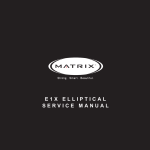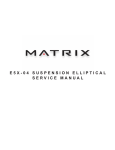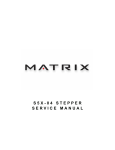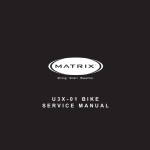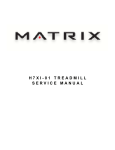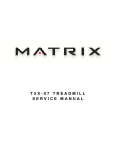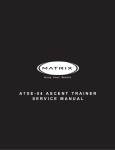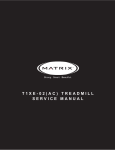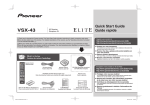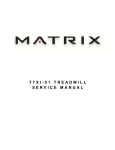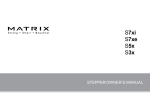Download E7xE-04 SUSPENSION ELLIPTICAL SERVICE MANUAL
Transcript
E7xe-04 SUSPENSION ELLIPTICAL
SERVICE MANUAl
Table of contents
CHAPTER 1: Serial number location ............................................................ 1
CHAPTER 2: Important Safety instructions
2.1
2.2
Read and Save These Instructions.............................................................................. 3
Electrical Requirements .............................................................................................. 4
CHAPTER 3: Preventative Maintenance
3.1
3.2
3.3
3.4
Recommended Cleaning Tips ..................................................................................... 5
Check for Damaged Parts .......................................................................................... 5
Care and Maintenance Instructions ............................................................................ 6
Touch Screen Care & Cleaning................................................................................... 7
CHAPTER 4: CONSOLE overlay and workout description
4.1
4.2
Console Description .................................................................................................... 8
Workout Setup Steps................................................................................................... 9
CHAPTER 5: Manager MODE
5.1
5.2
5.3
5.4
5.5 5.6
5.7
Manager
Manager
Manager
Manager
Manager
Manager
Manager
Mode
Mode
Mode
Mode
Mode
Mode
Mode
Overview............................................................................................. 10
- About Tab......................................................................................... 11
- Time Tab........................................................................................... 12
- Defaults Tab..................................................................................... 12
- TV Tab.............................................................................................. 13
- Language Tab................................................................................... 14
- Other Tab.......................................................................................... 15
CHAPTER 6: ENGINEERING MODE
6.1
6.2
6.3
6.4
6.5
6.6
6.7
Engineering
Engineering
Engineering
Engineering
Engineering
Engineering
Engineering
Mode
Mode
Mode
Mode
Mode
Mode
Mode
Overview........................................................................................ 16
- Calibration Tab............................................................................ 16
- Statistics Tab............................................................................... 17
- Errors Tab.................................................................................... 17
- Clubs Tab.................................................................................... 18
- Club ID Tab.................................................................................. 18
– Other Tab.................................................................................... 19
CHAPTER 7: Service mode
7.1
7.2
7.3
7.4
7.5
Service
Service
Service
Service
Service
Mode
Mode
Mode
Mode
Mode
Overview............................................................................................... 20
- Setup Tab........................................................................................... 21
- Test Tab.............................................................................................. 22
- Log Tab............................................................................................... 23
- Date / Time Tab.................................................................................. 23
CHAPTER 8: TROUBLESHOOTING
8.1
8.2
8.3
8.4
8.5
8.6
8.7
8.8
8.9
8.10
8.11
Electrical Diagram ....................................................................................................... 24
LCB LED Indicators..................................................................................................... 28
LCB Wiring Connections.............................................................................................. 29
Troubleshooting - Error 04A0....................................................................................... 30
Troubleshooting - Error 04B0....................................................................................... 31
Troubleshooting - Error 0248....................................................................................... 32
Troubleshooting - Error 02B4....................................................................................... 33
Troubleshooting - Error 02AB...................................................................................... 34
Troubleshooting - Error 01AC...................................................................................... 35
Troubleshooting - No Resistance Issues..................................................................... 36
Troubleshooting - Touch Pad Issues............................................................................ 37
Table of contents
8.12
8.13
8.14
8.15
8.16
Troubleshooting - Heart Rate Issues...........................................................................
TV Troubleshooting - Overview....................................................................................
TV Troubleshooting - Picture Fuzzy or Unclear...........................................................
TV Troubleshooting - TV Will Not Turn On..................................................................
TV Troubleshooting - Entertainment Keypad Issues...................................................
38
39
40
41
42
CHAPTER 9: PART REPLACEMENT GUIDE
9.1
9.2
9.3
9.4
9.5
9.6
9.7
9.8
9.9
9.10
9.11
9.12
9.13
9.14
9.15
9.16
9.17
9.18
9.19
9.20
9.21
Front Disk Replacement ............................................................................................. 43
Front Shroud Replacement.......................................................................................... 44
Lower Control Board (LCB) Replacement................................................................... 47
Generator Replacement............................................................................................... 48
Generator Belt Replacement....................................................................................... 50
Drive Belt Replacement............................................................................................... 51
Pulley Axle Set Replacement....................................................................................... 52
Drive Axle Set Replacement........................................................................................ 53
Crank Replacement..................................................................................................... 57
Console Replacement.................................................................................................. 58
Console Overlay / Keypad Replacement..................................................................... 59
Console Mast Handlebar............................................................................................. 61
Dual Action Handlebar Replacement........................................................................... 62
Foot Pedals Replacement............................................................................................ 63
Pedal Arm Replacement.............................................................................................. 64
Link Arm Replacement................................................................................................. 65
Swing Arm Replacement.............................................................................................. 66
Vertical Stabilizer Replacement................................................................................... 67
Incline Arm Cover Replacement.................................................................................. 68
Handlebar Service Replacement................................................................................. 69
Testing the Suspension Elliptical.................................................................................. 70
CHAPTER 10: EXPLODED DIAGRAMS
10.1
10.2
10.3 10.4
10.5
Suspension Elliptical Specifications ............................................................................ 71
Assembly Hardware..................................................................................................... 72
Suspension Elliptical Assembly Steps ........................................................................ 73
Leveling the Suspension Elliptical................................................................................ 85
TV Programming Instructions...................................................................................... 86
CHAPTER 11: SOFTWARE UPGRADE PROCEDURE
11.1
Software Upgrade Procedure...................................................................................... 88
iii
Chapter 1: Serial Number Location
1.1 SERIAL NUMBER LOCATION
SERIAL Number LOCATION
1
Chapter 1: Serial Number Location
1.1 SERIAL NUMBER LOCATION - CONTINUED
console serial number location
console Serial number location
2
Chapter 2: Important Safety Instructions
2.1 READ AND SAVE THESE INSTRUCTIONS
This Suspension Elliptical is intended for commercial use. To ensure
your safety and protect the equipment, read all instructions before
operating the MATRIX Suspension Elliptical.
CAUTION! If you experience chest pains, nausea, dizziness, or
shortness of breath, stop exercising immediately and consult
your physician before continuing. When using an electrical product, basic precautions should always be
followed including the following:
CAUTION! Any changes or modifications to this equipment
could void the product warranty. • A
n appliance should never be left unattended when plugged
in. Unplug the unit from the outlet when not in use and before
putting on or taking off any parts.
• T
his product must be used for its intended purpose
described in this service manual. Do not use other
attachments that are not recommend by the manufacturer.
Attachments may cause injury.
• T
o prevent electrical shock, never drop or insert any object
into any opening. • D
o not remove the console covers. Service should only be
done by an authorized service technician.
• Do not carry this unit by it’s supply cord or use the cord as a handle. • C
lose supervision is necessary when the Suspension
Elliptical is used by or near children or disable persons.
• Do not use outdoors. • D
o not operate where aerosol (spray) products are being
used or when oxygen is being administered.
• T
o disconnect, turn all controls to the off position, then
remove the plug from the outlet.
• D
o not use the equipment in any way other than designed or
intended by the manufacturer. It is imperative that all Matrix
Fitness Systems equipment is used properly to avoid injury.
• Keep hands and feet clear of moving parts at all times to avoid injury.
• Unsupervised children must be kept away from this equip
ment.
• Do not wear loose clothing while on the equipment.
3
Chapter 2: Important Safety Information
2.2 ELECTRICAL REQUIREMENTS
The Matrix Suspension Elliptical can now be self powered. It is recommended that the unit be plugged in for at least 4 hours after initial
installation to charge the battery prior to using the self powered feature. NOTE: If an add on TV (using a bracket) or Virtual Active is added to
the unit, it must be plugged in, or the TV or VA will not operate correctly. If the Suspension Elliptical will be plugged in, follow the requirements
below.
MATRIX DEDICATED CIRCUIT/ELECTRICAL REQUIREMENT INFO
All Matrix Suspension Elllipticals require the use of a 15 amp or 20 amp “dedicated circuit,” with a non-looped (isolated) neutral/ground, for the
power requirement. Quite simply this means that each outlet you plug Suspension ellipticals into should not have anything else running on that
same circuit besides other Suspension ellipticals (up to 3 per 15 amp circuit and 4 per 20 amp circuit). The easiest way to verify this is to locate
the main circuit breaker box, and turn off the breaker(s) one at a time. Once a breaker has been turned off, the only thing that should not have
power to it are the Suspension ellipticals in question. No lamps, vending machines, fans, sound systems, or any other item should lose power
when you perform this test.
Non-looped (isolated) neutral/grounding means that each circuit must have an individual neutral/ground connection coming from it, and terminating
at an approved earth ground. You cannot “jumper” a single neutral/ground from one circuit to the next.
In addition to the dedicated circuit requirement, the proper gauge wire must be used from the circuit breaker box, to each outlet that will have the
maximum number of units running off of it. If the distance from the circuit breaker box, to each outlet, is 100 ft or less, then 12 gauge wire may be
used. For any distance greater than 100 ft from the circuit breaker box to the outlet, 10 gauge wire must be used.
For your safety and Suspension Elliptical performance, the ground on this circuit must be non-looped. Please refer to NEC article 210-21 and 210-23.
Your Suspension elliptical is provided with a power cord with a plug listed below and requires the listed outlet. Any alterations of this power cord
could void all warranties for this product. Multiple Suspension ellipticals can be powered on one dedicated circuit. (3 units per 15 Amp and 4 units
per 20 Amp dedicated circuit.)
GROUNDING INSTRUCTIONS:
The Matrix E7xe-04 Suspension Elliptical must be grounded. If it should malfunction or break down, grounding provides a path of least
resistance for electric current to reduce the risk of electric shock. The Suspension Elliptical is equipped with a cord having an equipment
grounding conductor and a grounding plug. The plug must be plugged into an appropriate outlet that is properly installed and grounded in
accordance with all local codes and ordinances. If the user does not follow these grounding instructions, the user could void the Matrix limited
warranty.
DANGER: Improper connection of the equipment grounding conductor can result in the risk of electric shock. Check with a qualified electrician
if the user is in doubt as to whether the product is properly grounded. Do not modify the plug provided with the product if it will not fit the outlet,
have a proper outlet installed by an electrician.
CONSOLE POWER
The Matrix Suspension Elliptical console has a battery that makes it self powered. This means that even if the unit is not plugged in, the
console may still have power for up to 12 hours. If the console power needs to be reset or turned off, press and hold the CHANNEL UP and
CHANNEL DOWN keys for 3-5 seconds until the console turns off. The console power will also need to be reset if settings are changed in
Manager, Engineering, or Service Modes.
4
Chapter 3: Preventative Maintenance
3.1 RECOMMENDED CLEANING TIPS
In order to maximize life span, and minimize down time, all Matrix Fitness Equipment requires regularly
scheduled cleaning.
YOU WILL NEED:
-
Mild dish soap and water mixture in a spray bottle (10:1 water to soap ratio).
Lint free 100% cotton cleaning cloths or Micro fiber cleaning cloths.
Vacuum / Shop Vac with extendable hose and soft brush attachment.
Corrosion Block (available from Matrix - part # ZMS4001374).
DAILY:
1. Wipe down the unit after each use with a mild dish soap and water mixture. NOTE: Spray the soap / water mixture onto the cloth.
NEVER spray directly onto the equipment. We recommend that you do NOT allow customers to use spray bottles to clean the equipment. If
the cleaner is sprayed directly on the equipment or over spray is present, it may cause your equipment to rust and / or cause damage to console overlays.
WEEKLY:
1. With a clean dry 100% lint free cloth and water / soap mixture, wipe down the entire frame so it is free of dust, dirt, and sweat.
2. With a clean dry 100% lint free cloth and water / soap mixture, wipe down the entire console area including the hand grips and hand rails.
3. Use a computer screen cleaner or LCD / LED screen cleaner on the touch portion of the console.
MONTHLY:
1. Vacuum under and around the Elliptical Trainer. If you need to move it, unplug the unit first.
2. Vacuum debris out of the foot pedals.
3. Apply Corrosion Block to the metal part of the iPod cable.
3.2 check for damaged parts
DO NOT use any equipment that is damaged or has worn or broken parts. Use only replacement parts supplied by Matrix Fitness Systems.
maintain labels and nameplates. Do not remove labels for any reason. They contain important information. If unreadable or missing,
contact Matrix Fitness Systems for a replacement. 1-866-693-4863, www.matrixfitness.com
maintain all equipment Preventative maintenance is the key to smooth operating equipment. Equipment needs to be inspected at regular
intervals. Defective components must be replaced immediately. Improperly working equipment must be kept out of use until it is repaired.
Ensure that any person(s) making adjustments or performing maintenance or repair of any kind is qualified to do so. Matrix Fitness Systems will
provide service and maintenance training at our corporate facility upon request or in the field if proper arrangements are made.
5
Chapter 3: Preventative Maintenance
3.3 CARE AND MAINTENANCE INSTRUCTION
In order to maximize life span, and minimize down time, all MATRIX equipment requires regular maintenance items performed on a scheduled
basis. This section contains detailed instructions on how to perform these items and the frequency of which they should be done. Some basic
tools and supplies will be necessary to perform these tasks which include (but may not be limited to):
* Metric Allen wrenches
* #2 Phillips head screwdriver
* Adjustable wrench
* Teflon based spray lubricant such as “Super Lube”, or other Matrix approved product
You may periodically see an addendum to this document, as the Matrix Technical Support Team identifies items that require specific attention, the
latest version will always be available on the Matrix website, www.matrixfitness.com
DAILY MAINTENANCE ITEMS
1. Attempt to wobble the unit back and forth, level if needed (see Section 10.4).
QUARTERLY MAINTENANCE ITEMS
1.
Check all connecting joint areas for tightness of bolt assemblies.
2.
Ensure that there is little, or no free play at all joint assemblies once bolts have been tightened. Installation of washer kits may be required
if free play does not come out from tightening bolts.
3.
Remove plastic covers, and lubricate the ball joint where the Link Arm and Handlebar join together. Use your finger to apply grease to the
ball bearing. Matrix recommends using Superlube brand grease with PTFE {Teflon} additive.
YEARLY MAINTENANCE ITEMS
1.
6
Remove the front round covers and check the belts for damage, alignment, and proper tension.
Chapter 3: Preventative Maintenance
3.4 TOUCH SCREEN CARE & CLEANING
TOUCH SCREEN CARE AND CLEANING
* The touch screen requires very little maintenance. We recommend that you periodically clean the touch screen surface with a clean dry 100%
lint free cloth and water / soap mixture or a computer or LCD / LED screen cleaner.
* It is very important to avoid using any other chemical on the touch screen.
* Always dampen the cloth and clean the screen. Do not spray the water / soap mixture on the screen itself, the drips can seep into the display
or stain the bezel.
* After cleaning, make sure the surface is dry. There should not be any left over solvent to seep into the display.
* It is very important to handle the touch screen with care. Do not use excessive force when cleaning.
* Do not use any sharp materials to clean the touch screen surfaces.
* Do not use high pressure air, water, or steam to clean the touch screen surface.
7
Chapter 4: Console overlay and workout Description
4.1 CONSOLE DESCRIPTION
The E7xe-04 has a fully integrated touch screen display. All information required for workouts is explained on screen. Exploration of the interface
is highly encouraged. The information explaining how to program for various workouts will give an explanation about the contents of each screen.
GO: One touch Start.
STOP: Ends workout and shows workout summary data.
COOL DOWN (displayed on-screen during workout): Puts unit into Cool Down mode. Cool Down time is dependent on the length of the workout.
Workouts 19 minutes and shorter will have a cool down length of 2 minutes. Workouts 20 minutes and longer will have a cool down length of 5
minutes.
E7XE-04 ENTERTAINMENT ZONE
iPOD®: Will take the user directly to the iPod screen to allow for iPod control and playlist selection.
VOLUME UP / DOWN: Adjusts the volume output through the headphone jack of the integrated console TV or iPod output.
NUMBER KEYPAD: Allows for easy TV channel selections.
CHANNEL UP / DOWN: Allows for channel selection.
DISPLAY MODE: Allows user to cycle through console display options, iPod, TV, or profile display.
LAST CHANNEL: Allows the user to cycle between the current channel and the previous channel viewed.
CC/Mute: Mutes sound and turns closed captioning on or off.
8
Chapter 4: Console overlay and workout description
4.2 workout setup steps
To set up a workout, press the touch screen over the program you would like to use and then follow the prompts to begin your workout.
GO - Press to immediately begin a workout. Workout, resistance level, and time will automatically go to default settings. Pressing GO will not
prompt user for age, weight, or level settings.
MANUAL - Manual allows the user to input more information while defining their own workout. Calorie expenditure will be more accurate when
inputting information in Manual than by pressing GO.
FAT BURN - Fat burn is a level based program that is designed to help users burn fat through various resistance level changes.
ROLLING HILLS - The Rolling Hills program is a level based program that automatically adjusts the resistance level to simulate real terrain.
INTERVALS - The Intervals program is a level based program that automatically adjusts the resistance of the machine from low to high
intensity settings at regular intervals.
RANDOM - Random is a level based workout that randomly adjusts the resistance of the machine.
TARGET HEART RATE - The Matrix Suspension Elliptical comes with standard digital contact heart rate sensors and are POLAR
telemetry compatible. The heart rate control workout mode allows the user to program their desired heart rate zone, and the Suspension
Elliptical will automatically adjust the level based upon the user's heart rate. The heart rate zone is calculated using the following equation:
(220-Age)8%=target heart rate zone. The user must wear a POLAR telemetric strap or continually hold onto the contact heart rate grips for this
workout.
Locate the metal sensors on the handlebars of the Suspension Elliptical. Notice that there are two separate pieces of metal on each grip. You
must be making contact with both pieces of each grip to get an accurate heart rate reading. You can grab these sensors in any program to view
your current heart rate.
FITNESS TEST -The Cooper Fitness Test measures cardiovascular fitness and proves an estimated sub-maximal VO2 result. It is based on
power output according to ACSM standards and was developed by the Cooper Institute© (www.cooperinstitute.org). User RPMs must remain
between 60-80 RPM during the test. The test will end when the user can no longer maintain this speed. Use of a heart rate strap is optional but
provides more data.
The test starts at a low intensity level and gradually increases in intensity (difficulty) every 2 minutes. As it increases, the user must maintain
60-80 RPM to advance to the next level. The test could take upwards of 30+ minutes for very fit individuals. Once the test ends a recovery period
(cool down) will begin and the user's results are calculated and displayed. Results are based on the number of stages completed. Incline will not
be adjustable during the test.
STAGE COMPLETE:
1
2
3
4
5
6
7
8
9+
Well Below Average
Well Below Average
Below Average
Below Average
Average
Average
Above Average
Above Average
Well Above Average
CONSTANT WATTS - Constant Watts is a unique program that allows you to vary your cadence or RPM and the Suspension Elliptical's
resistance level will adjust accordingly to your selected goal. The quicker you pedal, the less resistance for the goal selected.
9
Chapter 5: Manager Mode
5.1 manager mode OVERVIEW
The Manager's Custom Mode allows the club owner to customize the Suspension Elliptical for the club.
1) To enter Manager Mode, press ENTER, 1, 0, 0, 1, ENTER on the lower display. Manager Mode will appear on the display (Figure A).
2) Follow the prompts to change the desired setting.
3) Press the ENTER key once the desired setting is correct to save.
4) Press HOME to return to normal operation. NOTE: If a setting has been changed, the unit and console power should be reset. Cycle the
power switch, and press and hold the CHANNEL UP and CHANNEL DOWN keys for 3-5 seconds to reset the console power.
figure a
10
Chapter 5: Manager Mode
5.2 manager mode - about tab
E7xe-02-C or E7xe-01-C - If the unit has the old MMM
board, the CSafe Model should be set for Off (even if
the MMM console is replaced).
E7xe-03-C - If the unit has the LMM board, the CSafe
Model should be set for On. The Suspension Style
Elliptical uses this console.
E7xe-04-C - If the unit has the LAM console (the
console cover back will have holes for ventilation), the
CSafe Model should be set for LAM.
manager mode
About
Function & defaults
descriptions
Serial Number
This option displays the serial number of the
platform and console. See Service Mode to
edit the serial numbers.
modified
Cannot be modified.
Accumulated Distance
Total distance on the unit since production.
Cannot be modified.
Accumulated Time
Total time on the unit since production.
Cannot be modified.
Software Versions
Software version.
Cannot be modified.
Out of Order
Default: Off
This option allows the club to show the unit
"out of order" if an error is present.
On / Off
CSafe Model
This option controls whether the console is
Fitlinxx compatible.
LMM / MMM / LAM
11
Chapter 5: Manager Mode
5.3 manager mode - time tab
Manager mode
Time
function & defaults
descriptions
modified
Max Time Default: 60 Minutes
This option allows the club to set the maximum workout
duration limits during peak and non peak hours.
Maximum: 99 Minutes
Minimum: 5 Minutes
Default Time Default: 30 Minutes
This option controls the default program time.
Max: Max Time Min: 5 Min
Pause Time Default: 5 Minutes
This option controls the default pause time.
Max: 10 Min Min: 1 Min
5.4 manager mode - defaults tab
12
manager mode
function & defaults
Defaults
Level Default: 1
This option controls the default program level.
description
Max: 1 Min: 20
modified
Age Default: 30
This option controls the default user's age used in the target HR
calculations.
Maximum: 100
Minimum: 10
Weight Default: 150 lbs
/ 68 kg
This option controls the default weight used in the calorie
calculations. Displayed in pounds or kilograms.
Maximum: 400 lbs / 182 kg
Minimum: 50 lbs / 22 kg
Gender Default: Male
Setting the user as Male or Female.
Male or Female
Key Sound Default: Yes
This option allows different sounds to be chosen for the keypad.
Yes or No
Chapter 5: Manager Mode
5.5 manager mode - tv tab
manager mode
TV
function & defaults
descriptions
modified
Default Channel
Default: 3
This option controls the default TV channel
on start up.
Channels 1-999
Default Volume
Default: 5
This option controls the default TV volume
on start up.
Maximum: 17
Minimum: 1
Tuner Available Default: Yes
This option controls the default TV function.
Yes or No
Setup
This option sets the TV tuner function.
On / Off
Remove TV
Default: No
This option controls the remote TV function.
NO or YES
Remove TV channel
Default: 1
This option controls the default remove TV
channel on start up.
Maximum: 37
Minimum: 1
Remove TV volume
Default: 15
This option controls the default remove TV
volume on start up.
Maximum: 15
Minimum: 1
13
Chapter 5: Manager Mode
5.6 manager mode - language tab
manager mode
Language
language
English
function & defaults
Select default language.
flag
unit
Mile
language
Spanish
14
modified
flag
unit
km
language
Chinese
km
Mile
German
descriptions
This option allows the user to select a flag for a
specific language.
KM
Dutch
km
KM
Italian
km
KM
Japanese
km
N/A
flag
unit
km
km
Portuguese
km
km
French
km
Chapter 5: Manager Mode
5.7 manager mode - About tab
engineering mode
Other
function & defaults
descriptions
modified
Asset Management
Default: Off
This option allows fitness clubs to collect workout
data to a PC.
On or Off
Virtual Active
Default: Off
This option control the Virtual Active function.
On or Off
15
Chapter 6: Engineering Mode
6.1 engineering mode overview
The Engineering Mode allows the club owner to keep track of the technical settings and error history for the Suspension Elliptical.
1) To enter Engineering Mode, press ENTER, 2, 0, 0, 1, ENTER on the lower display. Engineering Mode will appear on the display (Figure A).
2) Follow the prompts to change the desired setting.
3) Press the ENTER key once the desired setting is correct to save.
4) Press HOME to return to normal operation. NOTE: If a setting has been changed, the unit and console power should be reset. Cycle the
power switch, and press and hold the CHANNEL UP and CHANNEL DOWN keys for 3-5 seconds to reset the console power.
figure a
6.2 engineering mode - calibration tab
engineering mode
Calibration
16
function & defaults
descriptions
modified
RPM Low Limit Charge:
Default: 10
This option controls the RPM low limit to iPod
charge.
Range: 0 - 255
RPM Low Limit Resistance
Default: 10
This option control the RPM low limit to show
resistance.
Range: 0 - 255
Chapter 6: Engineering Mode
6.3 engineering mode - statistics tab
engineering mode
function & defaults
Statistics
descriptions
modified
This option displays the workout
information for the unit.
N/A
6.4 engineering mode - errors tab
engineering mode
Errors
function & defaults
descriptions
This option displays the error code
history for the unit.
modified
N/A
17
Chapter 6: Engineering Mode
6.5 engineering mode - clubs tab
engineering mode
function & defaults
Clubs
Default: MATRIX
descriptions
modified
This option allows the club to select a screen
header from a list.
N/A
6.6 engineering mode - club id tab
engineering mode
function & defaults
Club ID
18
descriptions
This option records the Club ID of
the fitness facility.
modified
N/A
Chapter 6: Engineering Mode
6.7 Engineering mode - Other tab
Engineering mode
Other
function & Defaults
Erp Time
Default: 0 minutes
descriptions
If there is no use of the machine over a
period of time, the console LEDs will turn
off (go into ErP mode).
modified
Maximum: 30 minutes
Minimum: 0
19
Chapter 7: Service Mode
7.1 service mode overview
The Service Mode allows an authorized service provider to test and store information on the Suspension Elliptical.
1) To enter Service Mode, press ENTER, 3, 0, 0, 1, ENTER on the lower display. Service Mode will appear on the display (Figure A).
2) Follow the prompts to change the desired setting.
3) Press the ENTER key once the desired setting is correct to save.
4) Press HOME to return to normal operation. NOTE: If a setting has been changed, the unit and console power should be reset. Cycle the
power switch, and press and hold the CHANNEL UP and CHANNEL DOWN keys for 3-5 seconds to reset the console power.
figure a
20
Chapter 6: Engineering Mode
7.2 service mode - setup tab
E7xe-02-F - All elliptical trainers should be set for this
model if rollers / tracks are present.
service mode
Setup
E7xe-03-F - This is for the suspension elliptical model
that has no rollers / tracks.
function & defaults
descriptionS
Machine Type Default: Elliptical
This option selects the current model.
Serial Number
This option displays the serial number of the console and frame.
Accumulated Distance
This option displays the accumulated workout distance since production.
Accumulated Time
This option displays the accumulated workout time since production.
Show Service on Boot
Factory Setting Only.
21
Chapter 7: Service Mode
7.3 service mode - test tab
E7xe-02--C Keypad - Old keypad Includes Quick Start Key
E7xe-03--C Keypad - Old keypad - Does
NOT Includes Quick Start Key
E7xe-04-C Keypad - New keypad -
service mode
Test
22
function & defaults
descriptions
modified
Keypad
This option is for a keypad test.
N/A
Touch Calibration
This option allows for a touch calibration of the
console. Follow the cross mark and touch the
screen to catch. After 5 positions are tested, touch
the center of the screen to exit this test.
N/A
Keypad Type
This option sets the keypad type for the console.
Quick Start or No Quick Start or
LAM
Radio Test
This option will test the radio signal for function.
N/A
Chapter 7: Service Mode
7.4 service mode - log tab
service mode
function & defaults
Log
descriptions
This option records key components
replacement history.
7.5 service mode - date & Time tab
service mode
function & defaults
Date & Time
descriptions
This option sets the current date and time on the
machine.
23
Chapter 8: Troubleshooting
8.1 Electrical DiagramS
24
Chapter 8: Troubleshooting
8.1 electrical diagramS - CONTINUED
25
Chapter 8: Troubleshooting
8.1 electrical diagramS - CONTINUED
Pulse Sensor Wire
POWER RESISTANCE WIRE
26
Chapter 8: Troubleshooting
8.1 ELECTRICAL DIAGRAMS - CONTINUED
Digital Communication Wire
ECB Wire
27
Chapter 8: Troubleshooting
8.2 LCB LED INDICATORS
====================== Firmware definition ========================
LED6: LCB status (blinking: OK)
LED7: Resistance Regulate Status (bright : Normal )
LED8: UCB/LCB Communication Status (blinking : OK )
====================== Hardware definition =======================
LED1: AC plug-in Status (bright : AC )
LED2: DC 5V Status (bright : OK)
LED3: AC plug-in Status (bright : AC )
LED4: DC 12V Status (bright : OK )
LED5: RPM
LED9: UCB Power Supply Status (bright: Power on)
LED10: Resistance PWM Status (bright: Resistance ON)
28
Chapter 8: Troubleshooting
8.3 LCB wiring connections
29
Chapter 8: Troubleshooting
8.4 troubleshooting - Error 04A0
ERROR CODE 04A0
1) SYMPTOM:
04A0 – PCB communication disconnected.
2) SOLUTION:
1) Check the connection of the console cable at the UCB and LCB. Also check the console cable for damage, replace as needed.
2) If the console cable connections are good, the issue is likely with the UCB. Replace the console.
3) If the console does not resolve the issue, replace the LCB.
Figure A
30
Figure B
Chapter 8: Troubleshooting
8.5 troubleshooting - Error 04b0
ERROR CODE 04B0
1) SYMPTOM:
04B0 – LCB communication disconnected.
2) SOLUTION:
1) Check the connection of the console cable at the UCB and LCB. Also check the console cable for damage, replace as needed.
2) If the console cable connections are good, the issue is likely with the UCB. Replace the console.
3) If the console does not resolve the issue, replace the LCB.
Figure A
Figure B
31
Chapter 8: Troubleshooting
8.6 troubleshooting - Error 0248
ERROR CODE 0248
1) SYMPTOM:
0248 –Battery disconnection or fail. (When the power is on, LCB battery voltage is less than 6 VAC)
2) SOLUTION:
1) Check the battery wire connection between the battery and LCB (Figure A).
2) Check the battery voltage (Figure B), if it is less than 6 VAC, replace the battery.
3) If the battery voltage is more than 6 VAC, replace the LCB.
Figure A
32
Figure B
Chapter 8: Troubleshooting
8.7 troubleshooting - Error 02B4
ERROR CODE 02B4
1) SYMPTOM:
02B4 – Resistance type error.
2) SOLUTION:
1) Check if the machine has the correct resistance system (resistor or ECB) (Figures A & B).
2) Check if the console is matched with the correct frame, and that the Machine Type is set correctly in Engineering Mode.
3) Replace the LCB.
4)..Replace the console. .
Resistor use on HUREA5x frame
Figure A
ECB use on SC5x frame and EP84 (ECB system E5x).
Figure B
33
Chapter 8: Troubleshooting
8.8 troubleshooting - Error 02AB
ERROR CODE 02AB
1) SYMPTOM:
02AB –Machine type error.
2) SOLUTION:
1) Check if the console machine type is matched with the correct frame in Engineering Mode.
Remarks: There are two types of E5x-F as below, each with different machine type in setting.
Machine type is E5x-02
Figure A
34
Machine type is E5x-03
Figure B
Chapter 8: Troubleshooting
8.9 troubleshooting - Error 01AC
ERROR CODE 01AC
1) SYMPTOM:
01AC - Resistance over current.
2) SOLUTION:
1) Check the resistance coming out of the resistor (Figure A).
--If the resistance value is under 8 ohms, replace the power resistor.
--If the resistance value is over 8 ohms, replace the LCB.
Figure A
35
Chapter 8: Troubleshooting
8.10 troubleshooting - NO RESISTANCE ISSUES
NO RESISTANCE TROUBLESHOOTING
1) SYMPTOM:
No resistance
2) SOLUTION:
1) Check the power resistance wire connection between the power resistor and LCB (Figure A).
2) Check the resistance coming out of the resistor (Figure A).
--If the resistance value is under 8 ohms, replace the power resistor.
--If the resistance value is over 8 ohms, replace the LCB.
Figure A
36
Figure B
Chapter 8: Troubleshooting
8.11 troubleshooting - touch pad issues
all or some of the function keys do not respond
possible causes:
1) The touch pad is not calibrated properly.
2) The UCB is damaged.
SOLUTION:
1) Perform a touch pad calibration in Service Mode:
a. Press ENTER, 3, 0, 0, 1, ENTER on the lower number keypad.
b. Press TEST on the display.
c. Press TOUCH CALIBRATION on the display.
d. Follow the cross mark moving across the screen and touch. After testing 5 positions, touch the center to exit the test (Figure A).
2) If the Touch Calibration does not work, replace the console.
figure a
37
Chapter 8: Troubleshooting
8.12 troubleshooting - heart rate issues
heart rate function does not work or is reading incorrectly
possible causes:
1)
2)
3)
4)
The
The
The
The
HR grips are not hooked up correctly.
HR grip wiring is damaged.
console or HR board is not properly grounded.
console, HR board, or wiring between are bad.
SOLUTION:
1) Perform a DC Voltage test on the HR grips.
a. With one prong of a multi meter on each of the plates on one side of the HR grip set (Figure A), a voltage reading of between .5 and 2.0
should be seen. If the reading is correct, the issue is not with the HR grips or grip wiring.
b. If the reading is not correct, remove the screws holding the halves of the HR grip together and check the connection of the wiring to the
grips (Figure B).
2) Remove the console from the unit and verify continuity of the HR grip wiring. With a multi meter set for ohms, place one prong on the HR grip
wiring coming up the console mast (Figure C), and the other on the appropriate plate (match red with red and white with white).
a. An ohm reading of less than 1 should be received. If it is higher, replace the HR grip wiring.
3) Perform a continuity check on the console (See Service Bulletin - Continuity Test on Matrix Elliptical Trainers).
a. Once the console continuity is confirmed, perform a continuity check on the HR board ground wire. With a multi meter set for ohms, place
one prong on the HR board ground wire (Figure D), and the other on the console ground wire. An ohm reading of less than 1 should be received.
If it is higher, replace the HR board.
4) If all the troubleshooting listed above has been performed, and the unit still has HR issues, replace the HR board.
a. If the HR board does not resolve the issue, replace the console.
38
figure a
figure B
figure C
figure D
Chapter 8: Troubleshooting
8.13 TV troubleshooting - Overview
Sections 8.13 - 8.16 will assist with diagnosing problems with TV and entertainment related equipment sold
by Matrix FItness Equipment. The Matrix Suspension Elliptical includes an integrated TV that shows in the large display window. The TV is capable of being shown as a 7" or
15" screen (Figures A & B). The console should be equipped with an entertainment keypad similar to Figure C.
figure b
Figure A
Figure C
39
Chapter 8: Troubleshooting
8.14 TV TROUBLESHOOTING - PICTURE FUZZY OR UNCLEAR
1) For a fuzzy or unclear picture, see the TV programming instructions in Section 10. If the TV is still fuzzy or unclear after programming:
a) Check the coax connection at the entertainment port (Figure A).
b) Remove the 5 screws holding the console to the console mast and check the coax connection at the console (Figure B).
Figure A
figure b
c) Use a verified good piece of coax cable (a good coax cable will have a signal strength of 10hz or greater) to plug directly into the back
of the console bypassing the entertainment port. If this resolves the issue, replace the internal coax cable.
d) If plugging the coax cable into the back of the console does not resolve the issue, remove the console back and check the console
cable connection at the tuner (Figure C).
e) Check the internal cables and fitting inside your machine at the console and below the front shroud (Figure D). Make sure you have
no kinks, cuts, or poor connectors at the end of the cable. Fittings should have a clean flush connector with no stray aluminum strands touching
the center conductor. Replace any suspect cables.
Figure C
figure D
f) If no damage can be found on the cables, fittings, or connectors, and hooking the coax directly to the back of the console does not
resolve the issue, replace the TV tuner.
40
Chapter 8: Troubleshooting
8.15 TV troubleshooting - TV WILL NOT TURN ON
1) Remove the console back and check the electrical connections for the TV (Figures A & B).
Figure A
Figure B
2) After you have verified that all connects are secure, and the problem still persists, verify power at the outlet (Figure C). If the outlet is not
outputting 120V, check the fitness room power.
3) If internal electrical connections are good, and the outlet is outputting 120V, the issue is likely with the TV. Replace the console.
Figure C
41
Chapter 8: Troubleshooting
8.16 TV TROUBLESHOOTING - ENTERTAINMENT KEYPAD ISSUES
ENTERTAINMENT KEYPAD IS NOT WORKING
1) SYMPTOM:
a. The entertainment keypad (Figure A) is not responding.
2) SOLUTION:
a. Remove the console and check the connection of the entertainment keypad (Figure B).
b. If the entertainment keypad cable is pinched, kinked, or cut replace the keypad.
c. If replacing the keypad does not resolve the issue, replace the console.
Figure A
42
figure b
Chapter 9: Part Replacement guide
9.1 FRONT DISK REPLACEMENT
1) Remove the center cover by turning it counter clockwise (Figures A & B).
figure a
figure b
2) Remove the 3 screws holding the disk to the axle (Figure C).
3) Remove the disk (Figure D).
figure c
figure d
4) Reverse Steps 1-3 to install a new disk. NOTE: The 3 screws removed in Step 2 should be torqued to 25 N-m.
43
Chapter 9: Part Replacement Guide
9.2 FRONT SHROUD REPLACEMENT
1) Remove the link arm and pedal arm plastic caps (Figures A & B).
FIGURE A
FIGURE B
2) Detach the dual action handlebar from the link arm (Figure C).
3) Secure the handlebar so that it is out of the way (Figure D).
FIGURE C
FIGURE D
4) Remove the front disks as outlined in Section 9.1.
5) Detach the pedal arm from the crank bearing assembly (Figure E).
6) Remove the 2 screws that hold the front top cover to the frame and remove the top cover (Figure F).
FIGURE E
44
FIGURE F
Chapter 9: Part Replacement guide
9.2 FRONT SHROUD REPLACEMENT - CONTINUED
7) Pull out the rubber tray from the cup holder plastic (figure G).
8) Remove the 2 screws to disassemble the cup holder plastic and remove it from the unit (Figure H).
figure G
figure H
9) Remove the 2 screws to disassemble and remove the middle stabilizer sweat cover (Figures I & J).
figure I
figure J
10) Remove the 1 screw (exposed when the cup holder is removed) holding the orange slot cover to the frame and remove it (Figure K).
11) Remove all of the cables from the front shrouds (Figure L).
figure K
figure L
45
Chapter 9: Part Replacement Guide
9.2 FRONT SHROUD REPLACEMENT - CONTINUED
12) Remove the 9 screws to detach the front shrouds from the frame (or each other) (Figure M).
13) Turn the crank to the slotted portion of the shroud (Figure N).
FIGURE M
FIGURE N
14) Remove the front shrouds for frame access (Figures O & P).
FIGURE O
FIGURE P
15) Reverse Steps 1-14 to install new shrouds. NOTE: The bolt / nut removed in Step 5 should be torqued to 70 N-m.
46
Chapter 9: Part Replacement guide
9.3 lower control board replacement
1) Turn off the power and disconnect the cord from the machine.
2) R
emove both front disks from the machine as outlined in Section 9.1.
3) Disconnect all wires from the LCB (Figure A).
figure a
4) Remove the 2 screws holding the LCB to the frame (Figure B).
figure b
5) R
everse Steps 1-4 to install a new LCB.
6) Test the Suspension Elliptical for function as outlined in Section 9.21.
47
Chapter 9: Part Replacement Guide
9.4 GENERATOR REPLACEMENT
1)
2)
3)
4)
5)
Turn off power and disconnect the cord from the machine.
Remove the front disks as outlined in Section 9.1.
Remove the front shrouds as outlined in Section 9.2.
Cut the cable tie holding the cable to the frame (Figure A).
Unplug the power cable connector of the generator (Figure B).
figure a
figure b
6) Loosen the nut holding the generator to the frame (Figure C).
7) Remove the three screws from the generator bracket (Figure D).
figure c
48
figure D
Chapter 9: Part Replacement guide
9.4 GENERATOR REPLACEMENT – CONTINUED
8) Remove the nut from the other side of the generator bracket (Figure E).
9) Loosen and remove the generator belt (Figure F).
figure e
figure f
10) Remove the generator from the frame.
11) Reverse Steps 1-10 to install a new generator. Re-install the belts as outlined in Section 9.5. NOTE: The 3 screws removed in Step 7
should be torqued to 8 N-m and the nut from Step 8 to 40 N-m.
12) Test the Suspension Elliptical for function as outlined in Section 9.21.
49
Chapter 9: Part Replacement guide
9.5 GENERATOR BELT REPLACEMENT
1)
2)
3)
4)
5)
Turn off the power and disconnect the cord from the machine.
Remove the front disks from the machine as outlined in Section 9.1.
Remove the front shrouds as outlined in Section 9.2.
Remove the generator as outlined in Section 9.4.
To install a new belt, first put the belt installation tool on the pulley (Figure A).
figure A
6) Put the new belt on the installation tool (Figure B).
7) Turn the pulley until the belt is installed. Rotate the pulley at least 3 full rotations to insure that the belt is centered.
figure B
8) Reverse Steps 1-4 to re-assemble the unit.
9) Test the Suspension Elliptical for function as outlined in Section 9.21. .
50
Chapter 9: Part Replacement Guide
9.6 Drive BELT REPLACEMENT
1) Turn off the power and disconnect the cord from the machine.
2) Remove the front disks from the machine as outlined in Section 9.1.
3) Loosen the belt tension bolt on the left side of the tension pulley and rotate the pulley counter-clockwise until there is enough slack in the
belt to remove it (Figures A & B).
figure a
figure b
4) Install the replacement belt and reverse necessary steps to secure the assembly until the belt is tight. NOTE: Tighten the drive belt to 180
lbs. for a new belt, 150 lbs. for a used belt. The idler bolt should be torqued to 80 N-m.
5) Test the Suspension Elliptical for function as outlined in Section 9.21.
51
Chapter 9: Part Replacement guide
9.7 PULLEY AXLE SET REPLACEMENT
1)
2)
3)
4)
Turn off the power and disconnect the cord from the machine.
Remove both front disks from the machine as outlined in Section 9.1.
Loosen the belt tension bolt on the right side until there is enough slack to remove the drive belt (Figure A).
On the right side of the frame, remove the retaining clip that holds the pulley axle bearing into the frame (Figure B).
figure a
figure b
5) On the left side of the frame, remove the retaining ring that holds the pulley axle bearing into the frame (Figure C).
6) Remove the pulley axle set assembly from the frame. Clean any debris from the hole in the frame (Figure D).
figure c
figure d
7) Reverse Steps 1-6 to install a new pulley axle set. Rotate the pulley to make sure that the motion is smooth and that there is no wobbling to
one side. Re-install the belts as outlined in Sections 9.5 and 9.6.
8) Test the Suspension Elliptical for function as outlined in Section 9.21.
52
Chapter 9: Part Replacement Guide
9.8 DRIVE AXLE SET REPLACEMENT
NOTE: A Matrix special tool is needed to correctly replace a drive axle. Order part # 0000094817 from Matrix CTS at 866-693-4863 ext 3. 1) Turn off the power and disconnect the cord from the machine.
2) Remove the front disks from the machine as outlined in Section 9.1.
3) Remove both belts as outlined in Sections 9.5 & 9.6.
4) On the left side of the frame, remove the retainer clip that holds the drive axle bearings in the frame (Figure A).
5) Install an M10 screw into the drive axle (Figure B).
figure a
figure b
6) Turn the screw until the head is close to the drive axle (Figure C).
7) Use a hammer to hit the screw until the drive axle assembly is loose in the frame, and remove it (Figure D).
figure c
figure D
8) Install the tool into the hole in the frame (Figure E).
9) Use a rubber mallet to hit the end of the tool until the bearing can be removed from the frame (Figure F).
figure E
figure F
53
Chapter 9: Part Replacement guide
9.8 DRIVE AXLE SET REPLACEMENT - CONTINUED
10) The drive axle should have come with an iron plate installed (Figure G).
11) Assemble the Matrix tool as shown in Figure H.
figure G
figure H
12) Slide the drive axle assembly into the frame from the right side. Install the bearing cap portion of the tool into the left side of the frame
(Figure I).
13) Mount the other tool from Figure H behind the bearing cap portion of the tool. Use the M10 x 65L screw with a washer and a nut to attach the
tool to the drive axle (Figure J).
figure I
figure J
14) Turn the screw at least 4 full revolutions into the drive axle. Then turn the nut until it is close to the cup portion of the tool (Figure K).
15) Use a wrench to hold the screw, then turn the nut to pull the drive axle into the frame (Figure L).
figure K
54
figure L
Chapter 9: Part Replacement Guide
9.8 DRIVE AXLE SET REPLACEMENT - CONTINUED
16) Turn the nut until the iron plate is close to the frame on the right side (Figure M).
17) Remove the tools, then insert the bearing into the hole in the frame on the left side (Figure N).
figure M
figure N
18) Again use the M10 x 65L screw with a washer and a nut to attach the tool to the drive axle (Figure O).
19) Turn the screw at least 4 full revolutions into the drive axle. Then turn the nut until it is close to the cup portion of the tool (Figure P).
figure O
figure P
20) Use a wrench to hold the screw, then turn the nut to push the bearing into the hole in the frame (Figure Q).
21) Insert the retainer clip to hold the bearing in the frame (Figure R).
figure Q
figure R
55
Chapter 9: Part Replacement guide
9.8 DRIVE AXLE SET REPLACEMENT - CONTINUED
22) Use a screwdriver to remove the iron plate from the drive axle (Figures S & T).
figure S
23) Re-install the belts as outlined in Sections 9.5 and 9.6.
24) Test the Suspension Elliptical as outlined in Section 9.21.
56
figure T
Chapter 9: Part Replacement Guide
9.9 CRANK REPLACEMENT
1) Turn off the power and disconnect the cord from the machine.
2) Remove the front disks from the machine as outlined in Section 9.1.
3) Remove the screw from the crank (Figure A).
4) Insert an M10 screw (should be at least 40 long) into the crank hole. Then turn the screw until the crank can be separated from the axle
(Figure B).
figure A
figure B
5) Install the replacement crank. There should be a 4mm gap between the end of the drive axle shaft and the crank (Figure C).
figure C
6) Install the crank screw. NOTE: This screw should be torqued to 80 N-m.
7) Reverse Steps 1-2 to re-assemble the unit.
57
Chapter 9: Part Replacement guide
9.10 CONSOLE REPLACEMENT
1) Turn off the power and disconnect the cord from the machine.
2) R
emove the 5 screws that hold the console to the top of the console mast (Figure A).
3) Disconnect the console cable and other wiring and remove the console (Figure B).
figure a
figure b
4) Remove the 5 screws that hold the mounting plate to the console (Figure C).
figure C
5) Attach the mounting plate to the new console.
6) Connect the wire connections to the new console.
7) Carefully push the wires into the console and mast until they are clear of the console / mast connection and attach the console to the mast
using the 5 screws removed in Step 2.
8) Test the Suspension Elliptical for function as outlined in Section 9.21.
58
Chapter 9: Part Replacement Guide
9.11 CONSOLE KEYPAD / OVERLAY REPLACEMENT
NOTE: The instructions below are for console overlays / keypads replacement, but the procedure is the same regardless of where the overlay /
keypad is.
1) Remove the console as outlined in Section 9.10.
2) Remove the back cover of the console (Figure A).
3) Unplug and remove the faulty overlay (Figure B).
Figure A
Figure B
4) Clean the console area with alcohol to remove any left over adhesive (Figure C).
5) Peel part of the protective film from the back of the overlay / keypad (Figure D).
Figure C
Figure D
59
Chapter 9: Part Replacement guide
9.11 CONSOLE KEYPAD / OVERLAY replacement - CONTINUED
6) Push the overlay / keypad ribbon cable through the hole in the console and plug it in (Figure E).
7) Match the overlay / keypad to the cutout in the console (Figure F).
Figure E
Figure F
8) Press down on the corners of the overlay / keypad to keep it in place. Then remove the protective film (Figure G).
9) Once the overlay / keypad is in the correct position, press down on it to adhere it in positions (Figure H).
Figure G
Figure H
10) Use the same procedure to replace any additional faulty overlays / keypads. NOTE: Overlays / keypads cannot be re-used.
11) Test the Suspension Elliptical for function as outlined in Section 9.21.
60
Chapter 9: Part Replacement Guide
9.12 CONSOLE MAST handlebar replacement
1) Turn off the power and disconnect the cord from the machine.
2) Remove the 4 bolts that hold the handlebar to the console mast (Figure A).
figure a
3) Pull the handlebar away from the console mast to expose the HR grip wiring (Figure B).
4) Carefully remove the wires from inside the console mast until the connectors on the ends come free and disconnect (Figure C).
figure B
figure C
5) To install a new handlebar assembly, connect the new handlebar and carefully push the heart rate wires into the console mast.
6) Attach the new handlebar assembly to the console mast using the 4 screws removed in Step 3.
7) Test the Suspension Elliptical for function as outlined in Section 9.21.
61
Chapter 9: Part Replacement Guide
9.13 dual action handlebar replacement
1) Remove the plastic cover where the dual action handlebar meets the link arm (Figure A).
2) Remove the bolt and bushings where the dual action handlebar and the link arm meet (Figure B).
figure a
figure b
3) Remove the two bolts that hold on the pivot cap and remove the cap (Figure C).
4) Unplug and separate the heart rate connector exposed once the pivot cap is removed. Then remove the 4 screws that hold the dual action
handlebar to the console mast (Figure D).
figure c
5) Reverse steps 1-4 to install a new dual action handlebar.
6) Test the Suspension Elliptical for function as outlined in Section 9.21.
62
figure d
Chapter 9: Part Replacement guide
9.14 FOOT PEDALS REPLACEMENT
1) Pull up on and remove the rubber portion of the pedal (Figure A).
2) Remove the 4 screws that hold the plastic pedal to the foot plate (Figure B).
figure a
figure b
3) Remove the plastic foot pedal (Figure C).
figure c
4) Clean the foot plate to remove any rubber or debris.
5) Reverse Steps 1-4 to install a new foot pedal.
6) Test the Suspension Elliptical as outlined in Section 9.21.
63
Chapter 9: Part Replacement Guide
9.15 PEDAL ARM REPLACEMENT
1) Remove the plastic cover where the pedal arm attaches to the crank (Figure A).
2) Disconnect the pedal arm from the crank (Figure B).
figure a
figure b
3) Remove the plastic cap from the swing arm (Figure C).
4) Remove the bolt that holds the pedal and swing arms together (Figure D).
figure c
figure d
5) The swing arm can now be separate from the pedal arm (Figure E).
6) Remove the bolt that holds the link arm to the pedal arm and remove the pedal arm (Figure F).
figure E
figure F
7) Reverse Steps 1-5 to install a new pedal arm. NOTE: Torque the bolt removed in Step 4 to 80 N-m and the bolt / nut removed in Step 2 to 70
N-m.
8) Test the Suspension Elliptical for function as outlined in Section 9.21.
64
Chapter 9: Part Replacement guide
9.16 link arm replacement
1) Remove the plastic cover where the dual action handlebar meets the link arm (Figure A).
2) Remove the bolt and bushings where the dual action handlebar meets the link arm (Figure B).
figure a
figure b
3) Remove the bolt that holds the link arm to the pedal arm and remove the link arm (Figure C).
figure C
4) Reverse Steps 1-3 to install a new link arm.
5) Test the Suspension Elliptical for function as outlined in Section 9.21.
65
Chapter 9: Part Replacement Guide
9.17 SWING ARM REPLACEMENT
1) Remove the bolt from the upper pivot joint on the swing arm (Figure A).
2) Remove the plastic cap from the swing arm (Figure B).
figure a
figure b
3) Remove the bolt that holds the swing arm to the pedal arm (Figure C).
4) Take the bolt removed in Step 1 and turn it into the shaft (Figure D).
figure C
figure D
5) Use a mallet to hit the head of the bolt until the swing arm can be separate from the pedal arm, and remove the pedal arm (Figures E & F).
figure E
figure F
6) Reverse Steps 1-5 to install a new swing arm. NOTE: Torque the bolts removed in Steps 1 & 3 to 80 N-m when installing a new swing arm.
7) Test the Suspension Elliptical for function as outlined in Section 9.21.
66
Chapter 9: Part Replacement guide
9.18 VERTICAL STABILIZER ARM REPLACEMENT
1) Remove the bolt that holds the vertical stabilizer arm to the frame (Figures A & B).
figure a
figure b
2) Remove the bolt from the upper pivot joint of the vertical stabilizer arm (Figure C).
3) Remove the vertical stabilizer arm (Figure D).
figure C
figure D
4) Reverse Steps 1-3 to install a vertical stabilizer arm. NOTE: Tighten the bolt removed in Step 2 to 80 N-m torque.
5) Test the Suspension Elliptical for function as outlined in Section 9.21.
67
Chapter 9: Part Replacement Guide
9.19 INCLINE ARM COVER REPLACEMENT
1) Remove the screw that holds the plastic cover on the arm (Figures A & B).
figure a
figure B
2) Remove the incline arm cover (Figure C).
figure C
3) Reverse Steps 1-2 to install a new incline arm.
68
Chapter 9: Part Replacement guide
9.20 HANDLEBAR SERVICE
1) All items on the handlebar are removed using a Phillips screwdriver from the underside of the bar.
2) Once the screws are removed, lift the part carefully, then disconnect any wire connections to fully remove the part. This includes the
resistance buttons and heart rate grip plates (Figures A & B).
figure a
figure B
69
Chapter 9: Part Replacement Guide
9.21 TESTING THE SUSPENSION ELLIPTICAL
Once the unit or replacement part is fully installed and assembled and
properly placed on the floor, use the following instructions to test
the machine:
1) Enter Service Mode (ENTER, 3, 0, 0, 1, ENTER) and input the serial number of the console. Also set the Machine Type (See Section 7.2)
and Keypad (See Section 7.3) and verify that the Date and Time are correct (See Section 7.5). NOTE: If a setting has been changed, the
unit and console power should be reset. Cycle the power switch, and press and hold the CHANNEL UP and CHANNEL DOWN keys for 3-5
seconds to reset the console power.
2) Enter Manager Mode (ENTER, 1, 0, 0, 1, ENTER) and turn on or off Asset Management or Virtual Active depending on whether the club has
these functions. NOTE: If a setting has been changed, the unit and console power should be reset. Cycle the power switch, and press and
hold the CHANNEL UP and CHANNEL DOWN keys for 3-5 seconds to reset the console power. Enter into and test Virtual Active.
3) Perform a channel scan on the TV.
4) Without hitting start or entering any exercise modes, stand on the machine and hold the handlebars while initiating movement to simulate
exercising. While moving listen for any odd noises or squeaks.
5) After stopping movement, press the green GO key and begin using the machine.
6) Grasp the hand grips to check for proper heart rate response.
7) Press the LEVEL UP and DOWN keys both on the hand grips and on the console to make sure resistance is fully functional.
8) If everything functions properly, stop pedaling and the unit will reset to normal operation after 30 seconds.
70
Chapter 10: Suspension Elliptical specifications and assembly guide
10.1 Suspension Elliptical specifications
MODEL NAME
E-3X/5X/7X
MODEL TYPE
E7XE ELLIPTICAL
FRAME PART #
E-3X/5X/7X-03-F
console part #
HURESAC-7xe-04-C
Features
Stride Length
21” / 53.3 CM
Incline Range
N/A
Contact & Telemetric HR sensors
Yes
Cushioned Footpads
No
pedal spacing
2.5” / 6.4 CM
Handlebar design
Multi-position dual action and custom ergo-bend stationary
Thumb switch controls
yes
Resistance System
Technology
Generator
Power Requirements
Self Powered - Powered 100-125 V, 60 HZ or 216-250 V, 50 HZ
Minimum watts
56 Self-Powered
Minimum RPM
10 Powered / 25 Self-Powered
Console
Display type
15” / 38.1 CM TOUCH SCREEN LCD
Display feedback
TIME ELAPSED, TIME REMAINING, TOTAL PROGRAM TIME,
CLOCK, DISTANCE (KILOMETERS OR MILES), CALORIES, CALORIES PER HOUR, SPEED, LEVEL, RPM, HEART RATE, METS,
WATTS, STATIC PROFILE DISPLAY, DYNAMIC PROFILE DISPLAY
User defined multi-language
display
Yes - English, German, French, Italian, Spanish, Dutch,
Portuguese, Chinese, Japanese, Korean, Swedish, Finnish, Russian, Arabic
Resistance levels
25
Workouts
MANUAL, ROLLING HILLS, INTERVAL TRAINING, FAT BURN, RANDOM, FITNESS TEST, HEART RATE, CONSTANT WATtS
CSAFE, FitLinxx ready
Yes
Netpulse Ready
no
Fit Touch Technology™
Yes
On-the-fly program change
Yes
Integrated Vista Clear™ digital
ready television
Yes - 15” / 38.1 CM SCREEN SIZE
FITCONNEXION™ ready
No
Wifi
Yes
ASSET MANAGEMENT COMPATIBLE
Yes
iPod Compatible
Yes
Nike + iPod Compatible
Yes
Personal Fan
Yes
Virtual Active™ compatible
Yes
Tech Specs
Overall dimensions
LxWxH
81x34x79"
1780x742x1740mm
Maximum user weight
400 lbs/182 kg
Weight
402 lbs/182.7Kg
Shipping weight
430 lbs/195.5Kg
71
Chapter 10: Suspension Elliptical specifications and assembly guide
10.2 ASSEMBLY HARDWARE
quantity
72
sketch
description
package color
4
Socket head cap screw
(M10 x 1.5P x 25L)
10.9 Grade minimum
red (2 bags)
4
flat washer
(10.2 x 20 x 2.0t)
Red (2 bags)
1
Socket head cap screw
(M10 x 1.5P x 100L)
12.9 Grade Minimum
green
2
Flat washer
(10.2 x 20 x 2.0T)
Green
1
hex Nut
(M10)
10.9 grade minimum
green
5
screw
(M5 x 0.8P x 10L)
Yellow
2
Screw
(M5 x 0.8 x 12L)
Black (2 bags)
4
Spring Washer
(8.2 x 15.4 x 2.0t)
black (2 bags)
4
Socket head cap screw
(M8 x 1.25P x 20L)
10.9 grade minimum
Black (2 bags)
1
socket head cap screw
(m8 x 1.25P x 45L)
10.9 grade minimum
Blue (2 bags)
3
screw
(M5 x 0.8P x 16L)
blue (2 bags)
4
socket head cap screw
(M8 x 1.25P x 25L)
White
4
Spring Washer
(8.2 x 13.5 x 2.0T)
White
12
Screw
(M5 x 0.8P x 16L)
Pink
1
ADAPTOR PLATE
(ONLY USED ON PREMIUM AND la
CONSOLE INCLUDING E5x FRAME)
Chapter 10: Suspension Elliptical specifications and assembly guide
10.3 SUSPENSION ELLIPTICAL ASSEMBLY STEPS
step 1
73
Chapter 10: Suspension Elliptical specifications and assembly guide
10.3 Suspension Elliptical assembly steps - continued
step 2 - RED HARDWARE BAG
74
Chapter 10: Suspension Elliptical specifications and assembly guide
10.3 SUSPENSION ELLIPTICAL ASSEMBLY STEPS - CONTINUED
step 3 - Pink hardware bag
75
Chapter 10: Suspension Elliptical specifications and assembly guide
10.3 Suspension Elliptical assembly steps - continued
step 4 - Green / Yellow HARDWARE BAG
Torque this bolt to 80 N-m.
76
Chapter 10: Suspension Elliptical specifications and assembly guide
10.3 SUSPENSION ELLIPTICAL ASSEMBLY STEPS - CONTINUED
step 5 - Red hardware bag
77
Chapter 10: Suspension Elliptical specifications and assembly guide
10.3 Suspension Elliptical assembly steps - continued
step 6
78
Chapter 10: Suspension Elliptical specifications and assembly guide
10.3 SUSPENSION ELLIPTICAL ASSEMBLY STEPS - CONTINUED
step 7 - Blue / Black hardware bag
79
Chapter 10: Suspension Elliptical specifications and assembly guide
10.3 Suspension Elliptical assembly steps - continued
step 8 - White hardware Bag
80
Chapter 10: Suspension Elliptical specifications and assembly guide
10.3 SUSPENSION ELLIPTICAL ASSEMBLY STEPS - CONTINUED
step 9 - pink hardware bag
81
Chapter 10: Suspension Elliptical specifications and assembly guide
10.3 Suspension Elliptical assembly steps - continued
step 10 - pink hardware Bag
82
Chapter 10: Suspension Elliptical specifications and assembly guide
10.3 SUSPENSION ELLIPTICAL ASSEMBLY STEPS - CONTINUED
step 11 - pink hardware bag
83
Chapter 10: Suspension Elliptical specifications and assembly guide
10.3 Suspension Elliptical assembly steps - continued
step 12 - pink hardware Bag
84
CHAPTER 10: SUSPENSION ELLIPTICAL SPECIFICATIONS AND ASSEMBLY GUIDE
10.4 leveling the Suspension Elliptical
STABILIZING the MATRIX Suspension Elliptical
The Matrix Suspension Elliptical should be level for optimum use. Once you have placed your unit where you intend to use it, raise or lower
one or both of the adjustable levelers located on the bottom of the frame. Use a 6mm Allen wrench through the access hole at the rear hinge
joint on both sides (Figure A).
figure a
85
Chapter 10: Suspension Elliptical specifications and assembly guide
10.6 tv programming instructions
Once the cardio equipment has been installed, and proper power and cable wiring is provided, The Television must be programmed to the club's
channels and settings.
Auto Scan - An auto scan will search for channel signals from the coax cable. It will tune in all channels that provide a signal.
1. Press ENTER, 1, 0, 0, 1, ENTER on the number keypad to enter Manager Mode.
2. Press TV on the display (Figure A).
3. Press SETUP on the display (Figure B). A TV will appear.
FIGURE A
FIGURE B
4. Press the - key on the number keypad and a Menu will appear on the TV (Figure C). NOTE: Once the Menu is present on the screen, the
following buttons must be pressed quickly, or the Menu will minimize after 5 seconds of no key strokes.
5. Use the CHANNEL UP and DOWN keys to move, ENTER key to enter this action in the Menu. Use the VOLUME UP and DOWN keys to
select item and ENTER key to start / change / save this setting item in the sub-menu.
6. Use the CHANNEL UP and DOWN keys to scroll the cursor to Installation of the Menu, then press the ENTER key to enter the Installation
sub-menu(Figure D).
FIGURE C
FIGURE D
7. Use the CHANNEL UP or DOWN keys to scroll down to Auto Scan (Figure E), then press the ENTER key to start the channel scan (Figure
F).
FIGURE E
86
FIGURE F
CHAPTER 10: SUSPENSION ELLIPTICAL SPECIFICATIONS AND ASSEMBLY GUIDE
10.6 tv programming instructions - continued
Auto Scan (continued):
8. If the channels are not coming in clearly after a channel scan (or if only some channels come in), follow Steps 4-7 to enter the Installation .
Use the CHANNEL UP or DOWN keys to change the TV System to match the club's incoming frequency (Figure G), then re-run Auto Scan.
10. If the channels are coming in clearly, press the HOME key to return to normal function (Figure H). If some channels are still not coming
in, are blurry, or are not scanning, follow the procedure below for adding / deleting a single channel. If no channels are coming in, see the
troubleshooting in Chapter 8.
FIGURE G
FIGURE H
Adding or Deleting a Single Channel - At times the Channel Scan can pick up channels that do not have a strong enough signal to
come in clearly or will fail to pick up channels that do come in clearly. Use the following procedure to manually add or delete a channel.
1. Follow Steps 1-4 in the Auto Scan instructions to access the TV Menu.
2. Use the CHANNEL UP or DOWN keys to scroll to Channel Management the Menu. Then press the ENTER key to enter the Channel
Management sub-menu.
3. Use the CHANNEL UP or DOWN keys to scroll to Hide / Show (Figure I). Then press the ENTER key to enter the Hide / Show sub-menu.
4. The Hide / Show sub-menu will show a list of channels available (Figure J). Channels with a check mark are scanned in and should show
up during normal TV usage.
5. To remove or add any channel, simply scroll to the channel using the CHANNEL UP or DOWN keys, and then press ENTER to add or delete
a check mark (which adds or deletes the channel).
6. Once the desired channels are scanned in, press HOME to return to normal operation.
FIGURE I
FIGURE J
87
Chapter 11: Software Upgrade guide
11.1 software upgrade procedure
* An AC power cord is required to update software in the field. Plug in the unit prior to beginning the update procedure. ** All plug ins must be removed prior to updating software (for example, no IPod can be connected). Do not use the console while an
update is in process. *** If VA is installed on the console, wait until the Virtual Active icon on the standard display picture turns red prior to updating the
software. 1) Five files should be present on the USB drive. These are: DrummuDeploy.cab, NK, IO_XXX, updateLMM.confige, and Extract_CE.
2) Turn on the power to the suspension elliptical, wait until the standard display picture has been come up (Figure A).
2) Enter Manager Mode by pressing ENTER, 1, 0, 0, 1, ENTER on the lower keypad.
3) Record the Accumulated Mileage, Accumulated Time, and Serial Number. NOTE: The information can be lost during the update procedure
and should be recorded so that the information can be entered into the newly updated console.
4) Press the HOME key to return to the standard display picture.
5) Wait until the Virtual Active icon turns RED. Insert the USB Drive into the USB port in the console (Figure B).
figure a
figure b
6) After a few seconds, the suspension elliptical will auto run the upgrade processing. The achieved percentage of the scheduled process will
be displayed in the bottom right corner of the display (Figure C).
7) When the update is complete, the display will ask you to remove the USB drive (Figure D). Once the USB drive is removed, turn off the
suspension elliptical and wait 10 seconds, then turn the suspension elliptical back on.
8) Enter Service Mode by pressing ENTER, 3, 0, 0, 1, ENTER on the lower keypad and check that the Machine Type is correctly set for
suspension elliptical and that the Service On Boot setting is NO. If the Machine Type is not correct, press ENTER, 3, 0, 0, 2, ENTER. This will
do a software parameter reset. Then change the Machine Type. Once the Machine Type is changed cycle unit and console power. Press the
HOME key to return to the standard display picture if the Machine Type is correct.
9) Also enter the values recorded in Step 3 in Service Mode (if needed).
figure C
figure D
9) Enter Manager Mode by pressing ENTER, 1, 0, 0, 1, ENTER on the lower keypad. Press SOFTWARE VERSIONS to verify that the new
software version is shown on the screen. Re-load software if any problems are seen.
10) Test the Suspension Elliptical for function as outlined in Section 9.21.
88
notes
89
M ATrix Fitness s y stems corp.
1610 Landmark D rive C ottage G rove wi 5 3 5 2 7 U S A
TO LL FREE 866. 693. 486 3 w w w. m a t r i x f i t n e s s . c o m FA X 6 0 8 . 8 3 9 . 1 7 1 7
REV. 01
KO
90





























































































